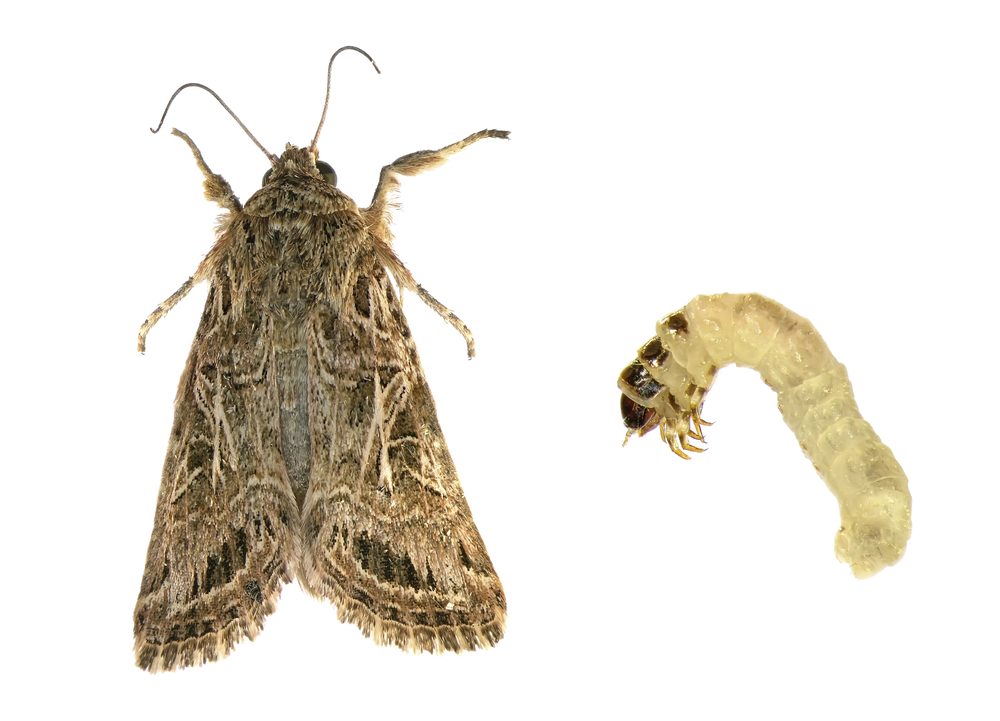Common Name: Casemaking Clothes Moth
Scientific Name: Tinea pellionella (Linnaeus)
Class/Order/Family: Insecta/Lepidoptera/Tineidae
Metamorphosis: Complete
Introduction
 This species is less commonly encountered and or far less economic importance than the webbing clothes moth. Its common name comes form the silken tube/case spun by the larva and which is carried about wherever the larva goes. The casemaking clothes moth is worldwide in distribution, but is more common in the southern United States.
This species is less commonly encountered and or far less economic importance than the webbing clothes moth. Its common name comes form the silken tube/case spun by the larva and which is carried about wherever the larva goes. The casemaking clothes moth is worldwide in distribution, but is more common in the southern United States.
Recognition
Adults measure about 3/8-1/2″ (10-14 mm) from wing tip to wing tip, both wings long and narrow. Body and wings buff to golden with brownish tinge, except for 3 dark spots on each front wing which may be indistinct or rubbed off with age. Hind wing fringed with long hairs. Eyes wider than space between them. Mature larva up to 3/8″ (10 mm) long. Whitish except for brown head and dorsal divided shield plate on prothorax. With 1 distinct ocellus on each side. Setae (hairs) IV and V (near and below spiracle) on 7th abdominal segments 3-4-5-6 and 10 (anal/last segment), with crochet (hooks on ends) arranged in single complete ellipse on prolegs 3-6.
Similar Groups
(1) Webbing cloths moth (Tineola bisselliella) adult lacks 3 dark spots on wing, has reddish tuft on head. (2) Carpet/tapestry moth (Trichophaga tapetzella) adult with basal/inner 1/3 of front wing dark, remainder white mottled with dark specks. (3) Angoumois grain moth (Sitotroga cerealella) adult hind wing with tip abruptly narrowed towards front margin, hair fringe on hind margin/edge about as long as wing is wide, whitish stripe running from base to beyond center of wing. (4) Mediterranean flour moth (Anagasta kuehniella) adult front wing gray with black cross lines, wing span 3/4-1″ (20-25 mm). (5) Indianmeal moth (Plodia interpunctella) adults front wing with basal/inner 1/3 buff colored, outer 2/3’s coppery brown, wing span 5/8-3/4″ (16-19 mm). (6) Other moths generally much larger, attracted to light.
Damages
Silken cases which are cigar-shaped, open-ended, 1/16-3/8″ (1.5-10mm) long, with pieces of infested material incorporated into the case, and usually attached to the material at one end, contain the larva. Surface feeding/grazing in irregular furrows or holes if infestation severe. The case-containing the pupa is usually located in a crack or crevice, not on the infested material.
Biology
Females mate on the day they emerge as adults and can start laying eggs the next day. They lay an average of about 37-48 eggs (range 8-83) singly on suitable larval food. The eggs hatch in 4-7 days and the larva wanders about for 24 hours. The larval stage lasts about 33-90 days depending on temperature and humidity, during which there will be 5-11 molts. The mature larva seeks a sheltered place to pupate, and pupation lasts about 9-19 days depending on the temperature. Developmental time (egg to adult) takes from 46-116 days. Female adults live about 3-8 days and males live about 3-5 days.
Habits
Casemaking clothes moth larvae attack primarily materials of animal origin and secondarily those of plant origin. Animal-origin materials include feathers, wools, rugs, furs, mummified carcasses, taxidermy mounts, and piano felts. Plant-origin materials include tobacco, various herbs and seasonings, hemp, various plant-based drugs, linseed, almonds, saffron, etc. It is particularly a pest of feathers/down and hair/fur. The larva moves by extending its head and toracic legs out of its case and then drags the case along. It can feed from either end of the case. The larva usually grazes here and there causing only surface furrows bout may occasionally cause holes by feeding in one place for some time. It rarely spins silk on the material. When it is ready to pupate, the larva seeks a protected place, such as a crack or crevice which is usually off the infested material. Adults do not feed. They shun light, not being attracted to lights as are most moth species. The males are smaller and are active fliers whereas, the females are sluggish and fly only short distances.
Control
The key to control is proper identification, a thorough inspection, good sanitation, and pesticide application when required. Refer to this section under general treatment of fabric and paper pests for details. If the source(s) of the infestation cannot be found in the usual places check the air ducts and especially the cold air return. If this is a problem area, the ducts should be professionally cleaned. If pets are or have been present, check where pet hair may accumulate such as behind and under baseboards, between cracks of flooring, etc.